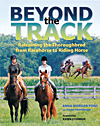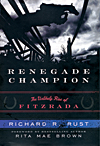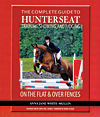 Beyond The Track: Retraining The Thoroughbred From Racehorse To Riding Horse.
Beyond The Track: Retraining The Thoroughbred From Racehorse To Riding Horse.
Anna Morgan Ford with Amber Heintzberger.
Trafalgar Square Books, 388 Howe Hill Rd., North Pomfret, VT 05053.
252 pp. Photographs. 2008.
$29.95
Retraining off-the-track Thoroughbreds for a non-racing career has been an important part of our sport horse industry for many years. It can be a long, stressful journey, but the end is often rewarding. Beyond The Track is a comprehensive guide to re-training the race horse, and a handy reference for exercises, feeding regimens and understanding life at the track.
The book is thorough in its approach. The author, Anna Morgan Ford, starts at the beginning, diving into a race horse’s life starting with the extensive bloodline research that often occurs before breeding. She delves into a foal’s early life, the preparations involved for auctions and sales, and the training methods that mold the young horses into racers.
I found the first two chapters especially interesting, because it really gives the reader a clear picture of the life of a race horse and made the rest of the book easier to comprehend. The author often relates behavioral issues to what the horses were conditioned to at the track.
I thought the most valuable sections of the book were the two chapters that focused on transitioning your OTTB from track life to home life. She stresses the idea of keeping every situation positive and non-stressful, and encourages a welcoming and safe environment. She discusses how to put together a good feeding program and to determine hay quality, common causes of weight loss, how to introduce your horse to turnout and how to handle him with confidence.
The rest of the book is dedicated to re-training, and I really liked her philosophy of slow progress. Ford starts the section with an outline of a training schedule and writes about various forms of training. The training methods are not groundbreaking or new, but solid, basic systems that have been adapted to the OTTB’s unique experiences. The final section of the book is dedicated to success stories, including Hilda Gurney’s Keen and Becky Holder’s Courageous Comet.
Overall, this book was well written, organized and comprehendible. The pictures aided the text nicely, and my only critique is that at times there was too much information, and I found myself getting lost in the text. The overall concept and execution was well done, however, and I recommend this book to any potential OTTB owner.
Coree Reuter
ADVERTISEMENT
 Renegade Champion: The Unlikely Rise Of Fitzrada.
Renegade Champion: The Unlikely Rise Of Fitzrada.
Richard R. Rust.
The Rowan & Littlefield Publishing Group, Inc. 4501 Forbes Blvd., Suite 200, Lanham, MD 20706.
299 pp. Photographs. 2008.
$24.95.
When U.S. show jumping Chef d’Equipe George Morris suggested I read this book a few weeks ago, I had a feeling it would be a worthwhile endeavor. And, of course, it was.
Richard Rust’s book chronicles the life of his mother, Jane Pohl (1924-2001), a prominent show jumper of the 1940s. She was one of the first women to break into the then male-dominated sport.
Pohl grew up in a military family and stumbled upon Fitzrada through a set of circumstances that proves sometimes you just have to be in the right place at the right time. She persevered through rehabilitating “Fitz” from an untrustworthy rogue to a star show jumper at the highest levels, and along the way you begin to see and understand how perseverance and faith are the cornerstones of her personality.
This true story reads like a Hollywood script but better. Unlike many biographies, this one is decorated with anecdotes that only a child would pick up through a lifetime spent with his mother. He does a masterful job of relating facts and blending them with these wonderful tidbits, so that the reader seems to feel what’s going through Pohl’s mind rather than simply reading her words.
Rust doesn’t write this biography chronologically either, which for me was yet another bonus, and reflects the care he took in crafting this book. Sixteen black-and-white photographs in a center signature include images of Pohl’s youth and the peak of her show jumping career with Fitz, so don’t forget to view them before you begin the book.
Sadly, the author died in February of 2008 before this book was released. I think he would have enjoyed knowing that his story was so well received in our world 60 years after the apex of his mother’s career.
While I’m a firm believer that you should pass on good books to friends to also enjoy, this is one that will remain in my collection.
ADVERTISEMENT
Tricia Booker
 The Complete Guide To Hunter Seat Training, Showing, And Judging.
The Complete Guide To Hunter Seat Training, Showing, And Judging.
Anna Jane White-Mullin, Trafalgar Square Books, P.O. Box 257, North Pomfret, VT 05053. 351 pp.
Color photographs, diagrams. 2008.
$34.95.
Every riding academy in the United States most likely has a shelf full of excellent riding manuals in the tackroom, but you probably can’t find those useful but dry classical volumes for all the magazines and colorful coffee table histories stacked on top of them. Luckily, Maclay Finals winner and U.S. Equestrian Federation R-rated judge Anna Jane White-Mullin has come out with a contemporary volume that’s practical, attractive and accessible enough to earn a spot on the top of the pile.
The Complete Guide To Hunter Seat Training, Showing, And Judging—part riding manual, part judging guide, part exercise guide—borrows heavily from White-Mullin’s previous tomes. The new version benefits from lush contemporary photography featuring several of the equitation ring’s current and past stars who will draw in plenty of readers whose patience for the book-learning side of the sport has been tried by limited and dated illustrations that usually accompany such guides.
True to its title, this book covers an awful lot of ground, producing a user-friendly text, but also an analysis that’s occasionally too shallow.
For example, the chapter on USEF Equitation Tests 1-19 focuses on teaching individual movements while skimming over changing horses (test 16) and designing a demonstration ride (test 19)—the two tests for which I would most like to read a judge’s practical advice to riders.
This edition tackles too much in too few pages to truly replace the dusty hardcovers on that shelf, but it’s an easy read rather than a daunting reference.
The book’s second half on judging will prove invaluable, in particular, for every first-time horse show parent. Were I still teaching I would gift wrap a copy for every parent before his or her child’s first competition. The book mercifully assumes a solid familiarity with the basics, rendering it a bit too sophisticated for beginners but a great guide for anyone with an interest in the hunters or equitation.
Mollie Bailey






